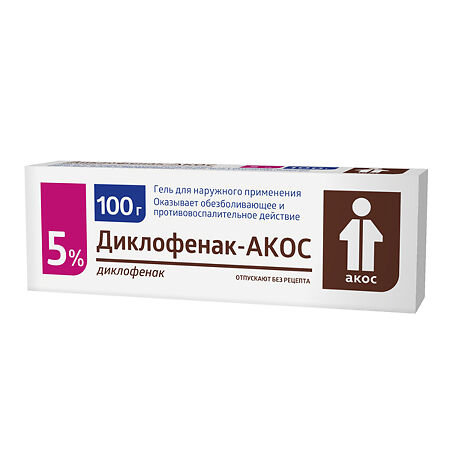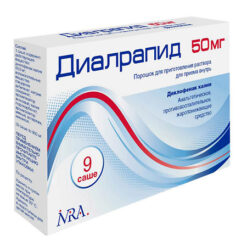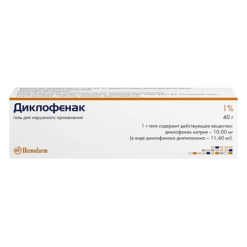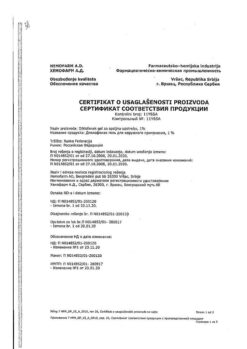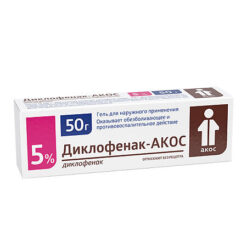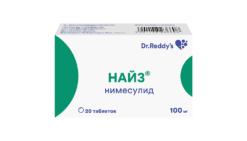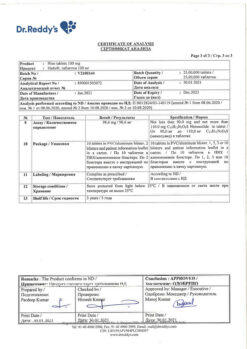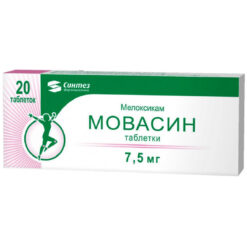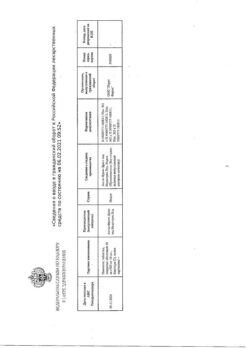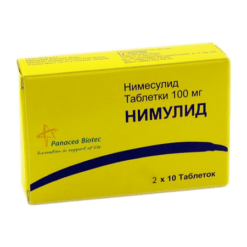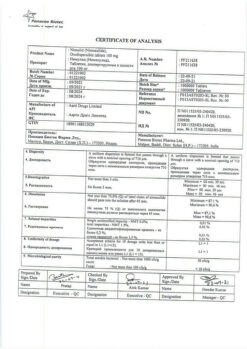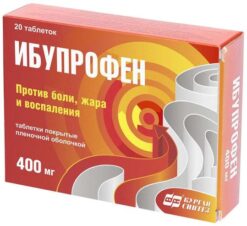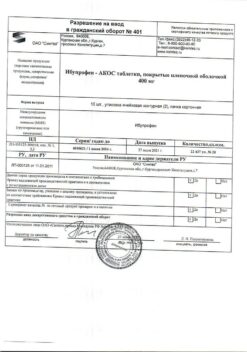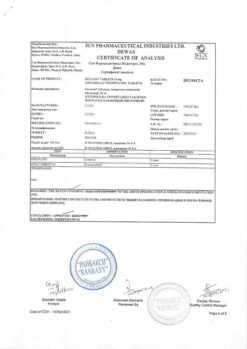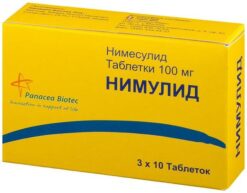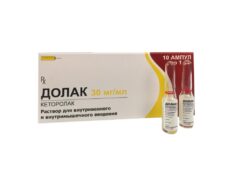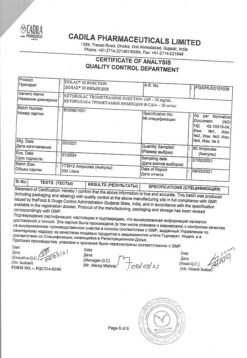No products in the cart.
Diclofenac-ACOS, gel 5% 100 g
€16.06 €14.41
Description
Pharmacotherapeutic group: Non-steroidal anti-inflammatory drug (NSAID).
ATX code: M02AA15
Pharmacological properties
Pharmacodynamics
. The active ingredient diclofenac is a non-steroidal anti-inflammatory drug (NSAID) with pronounced analgesic and anti-inflammatory properties. Indiscriminately inhibiting cyclooxygenase type 1 and 2, disrupts the metabolism of arachidonic acid and the synthesis of prostaglandins, which are a major link in the development of inflammation. Diclofenac is used to eliminate pain syndrome, inflammation in joints, muscles and ligaments of traumatic or rheumatic origin, helps reduce pain and swelling associated with inflammation, increase joint mobility.
Pharmacokinetics
When applied externally, diclofenac penetrates well through the skin, mainly concentrating in the focus of inflammation and synovial fluid. The amount of diclofenac that is absorbed through the skin is proportional to the time of contact of the gel with the skin and the area where it is applied, depending on the total dose of the drug and the degree of hydration of the skin. With the recommended method of application absorption is not more than 6%. Binding with blood plasma proteins is 99.7 %. It is excreted by the kidneys. When applied to the area of the affected joint the concentration in synovial fluid is higher than in plasma.
Indications
Indications
– post-traumatic inflammation of soft tissues, for example, due to sprains, strains, bruises, injuries;
– rheumatic diseases and swelling of soft tissues (tenosynovitis, bursitis, damage to periarticular tissues, wrist syndrome);
– pain in the joints (joints of the fingers, knees, etc.) with osteoarthritis;
– back pain due to inflammatory and degenerative diseases of the spine (osteoarthrosis, radiculitis, lumbago, sciatica).
The drug is intended for symptomatic therapy, reducing pain and inflammation at the time of use, and does not affect the progression of the disease.
Pharmacological effect
Pharmacological effect
Pharmacotherapeutic group: non-steroidal anti-inflammatory drug (NSAID).
ATX code: M02AA15
Pharmacological properties
Pharmacodynamics
The active component diclofenac is a nonsteroidal anti-inflammatory drug (NSAID) with pronounced analgesic and anti-inflammatory properties. Indiscriminately inhibiting cyclooxygenase types 1 and 2, it disrupts the metabolism of arachidonic acid and the synthesis of prostaglandins, which are the main link in the development of inflammation. Diclofenac is used to eliminate pain, inflammation in joints, muscles and ligaments of traumatic or rheumatic origin, helps reduce pain and swelling associated with the inflammatory process, and increases joint mobility.
Pharmacokinetics
When applied externally, diclofenac penetrates well through the skin, mainly concentrating in the site of inflammation and synovial fluid. The amount of diclofenac that is absorbed through the skin is proportional to the time of contact of the gel with the skin and the area of its application, depending on the total dose of the drug and the degree of skin hydration. With the recommended method of application, absorption is no more than 6%. Connection with blood plasma proteins – 99.7%. Excreted by the kidneys. When applied to the area of the affected joint, the concentration in the synovial fluid is higher than in the plasma.
Special instructions
Special instructions
Apply externally only. The gel should be applied only to intact skin, avoiding contact with open wounds. After applying the gel, do not apply an occlusive dressing.
When used in patients with gastric and duodenal ulcers, dysfunction of the liver, kidneys or hematopoietic system, as well as when using other NSAIDs simultaneously, consult a doctor.
When using the drug together with other dosage forms of diclofenac, the maximum daily dose should be taken into account.
With long-term use and/or application to large surfaces, systemic adverse reactions may develop due to resorptive effects.
Avoid contact of the drug with the eyes, mucous membranes or open wounds.
The drug contains propylene glycol, which may cause local skin irritation. Treatment should be discontinued if a skin rash develops after application of the drug.
Impact on the ability to drive vehicles and machinery
The drug does not affect the ability to drive vehicles and other machinery.
Active ingredient
Active ingredient
Diclofenac
Composition
Composition
Active ingredient: diclofenac sodium – 5.0 g.
Excipients: ethanol (96% alcohol), propylene glycol, hydroxyethylcellulose (hyetellose, natrosol), lavender oil, purified water.
Pregnancy
Pregnancy
The drug should not be used in the third trimester of pregnancy.
Use in the first and second trimesters is possible only after consultation with a doctor if the expected benefit to the mother outweighs the potential risk to the fetus.
There is no experience with the use of the drug during breastfeeding.
Due to the lack of data on the penetration of the drug into breast milk, its use during breastfeeding is not recommended. If you still need to use the drug, then you should not apply it to the mammary glands or large surfaces of the skin and do not use it for a long time.
If you are pregnant, think you might be pregnant, or are planning to become pregnant, you should consult your doctor before using diclofenac.
Contraindications
Contraindications
– hypersensitivity to diclofenac or other components of the drug;
– complete or incomplete combination of bronchial asthma, recurrent polyposis of the nose and paranasal sinuses, intolerance to salicylates or other NSAIDs (including a history);
– pregnancy (III trimester);
– period of breastfeeding;
– children’s age (up to 12 years);
– violation of the integrity of the skin at the intended site of application.
With caution
Hepatic porphyria (exacerbation), erosive and ulcerative lesions of the gastrointestinal tract (including peptic ulcer of the stomach and duodenum), severe dysfunction of the liver and kidneys, chronic heart failure, bleeding disorders (including hemophilia, prolongation of bleeding time, tendency to bleed), bronchial asthma, old age, pregnancy I and II trimester.
Side Effects
Side Effects
The frequency of occurrence of adverse reactions is classified as follows: very often (≥1/10), often (from ≥1/100 to <1/10), infrequently (from ≥1/1000 to <1/100), rarely (from ≥1/10000 to <1/1000), very rarely (<1/10000), including individual reports.
Local reactions: uncommon – exudative erythema multiforme (including Stevens-Johnson syndrome), eczema; rarely – bullous dermatitis; very rarely – contact dermatitis (itching, hyperemia, swelling of the treated skin area, pustular rash, papular-vesicular rashes, peeling).
When applying the gel to large surfaces of the skin over a long period of time, systemic side effects of diclofenac may develop.
Systemic reactions: rarely – generalized skin rash, allergic reactions (urticaria, angioedema, bronchospastic reactions), asthma, photosensitivity; very rarely – anaphylactic reactions (including shock).
If any of these side effects worsen or you notice any others not listed in the instructions, tell your doctor.
Interaction
Interaction
The use of the drug with other NSAIDs is not recommended.
Diclofenac may enhance the effect of drugs that cause photosensitivity. Clinically significant interactions with other drugs have not been described.
Overdose
Overdose
Due to the low systemic absorption when applying the gel, an overdose is unlikely.
In case of accidental ingestion, systemic adverse reactions may develop.
Symptoms: nausea and vomiting.
Treatment: gastric lavage, induction of vomiting, activated charcoal, symptomatic therapy.
Hemodialysis and forced diuresis are not effective due to the degree of binding of diclofenac to plasma proteins (about 99.7%).
Storage conditions
Storage conditions
At temperatures from 15 to 25 °C.
Freezing is not allowed.
Keep out of the reach of children.
Shelf life
Shelf life
3 years.
Do not use after expiration date.
Manufacturer
Manufacturer
Sintez, Russia
Additional information
| Shelf life | 3 years. Do not use after the expiration date. |
|---|---|
| Conditions of storage | At the temperature from 15 to 25 ° C. Freezing is not allowed. Store out of the reach of children. |
| Manufacturer | Sintez OAO, Russia |
| Medication form | gel for external use |
| Brand | Sintez OAO |
Other forms…
Related products
Buy Diclofenac-ACOS, gel 5% 100 g with delivery to USA, UK, Europe and over 120 other countries.

